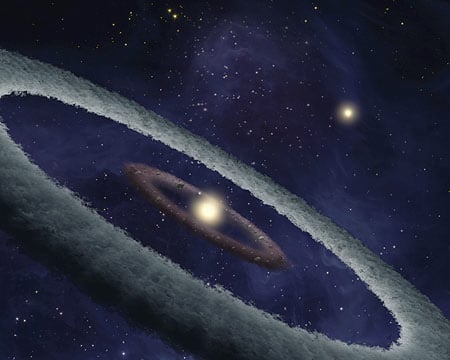This article is more than 1 year old
Astronomers witness birth of a mini-Earth
Distant rocky planets emerging from the dust
A long time ago, in a star system far, far away, an Earth-like planet is forming. It is actually only 424 light years away in a system known as HD 113766, outside the reach of your Oyster cards* but a mere stroll in astronomical terms.

Artists' impression of the forming planet.
Scientists using the Spitzer Space Telescope have spotted a very young star, just ten million years old, encircled by a huge disk of warm dust - more than enough to build a Mars-sized planet. The age and set-up look just right for the formation of rocky planets, the researchers say.
"The timing for this system to be building an Earth is very good," said Dr. Carey Lisse, of the Johns Hopkins University Applied Physics Laboratory. "If the system was too young, its planet-forming disk would be full of gas, and it would be making gas-giant planets like Jupiter instead. If the system was too old, then dust aggregation or clumping would have already occurred and all the system's rocky planets would have already formed."
Lisse explains that the mix of materials is just right, too. Analysing data from the Spitzer, he determined that the dust is in conditions roughly halfway between the primordial (which we know about from missions to comets and from analysis of meteorites) and the stable planets we find in our solar system.
"The material mix in this belt is most reminiscent of the stuff found in lava flows on Earth," said Lisse.
He says the disk contains no water ice, carbonates, or fragile organic materials like those found when NASA smashed a probe into the comet Tempel-1. But nor has the mixture totally differentiated. That is to say, the metals are still mixed in with the rocky materials. When planets are formed, the metals collect in the centre (although the mechanism by which this happens is still hotly debated).
"It is fantastic to think we are able to detect the process of terrestrial planet formation. Stay tuned - I expect lots more fireworks as the planet in HD113766 grows," he adds.
Lisse's paper will be published in an upcoming issue of Astrophysical Journal. ®
*A pre-pay travel system for the good city of London.
